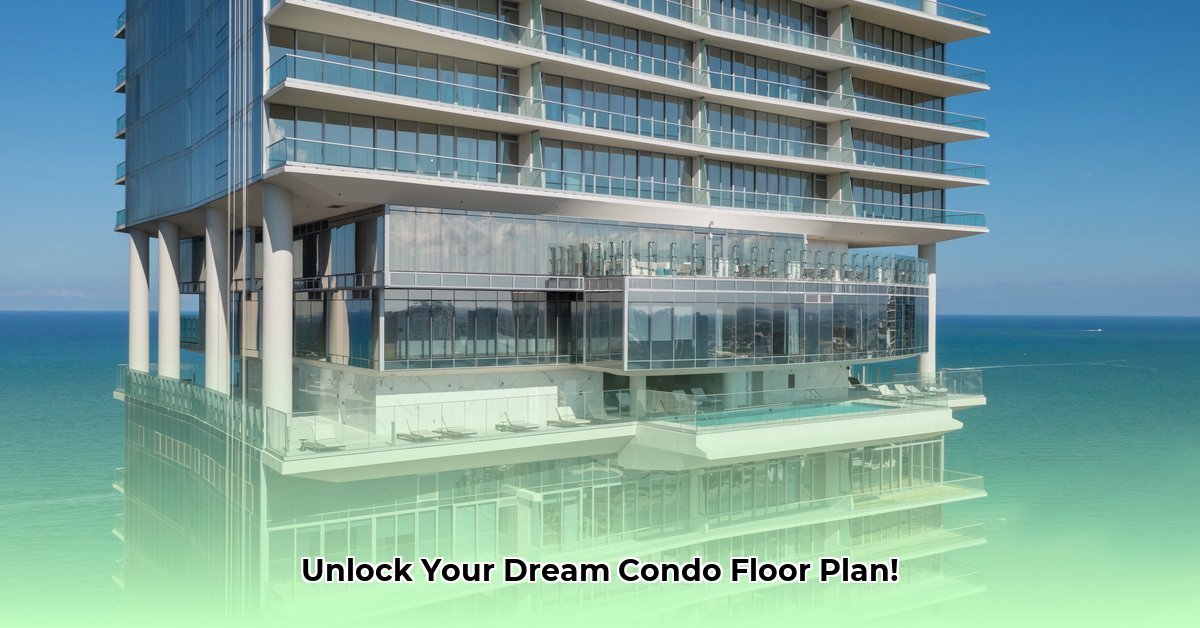Buying a condo is a significant decision, and choosing the right floor plan is a crucial part of it. This guide simplifies the process, walking you through everything from understanding different layouts to considering location, budget, and future needs. We’ll cover various floor plan types, offer tips to avoid costly mistakes, delve into ownership types, and even help you think about how your choice impacts your lifestyle and investment potential. For more visual examples, check out these [apartment floor plans](https://www.wavesold.com/apartment-floor-plan). Let’s find the perfect condo for you!
Understanding Condo Floor Plans: Decoding the Blueprint and Space Efficiency
So, you’re thinking about buying a condo? Awesome! But before you get swept away by sleek appliances and stunning views, let’s talk about something equally crucial: the floor plan. It’s the blueprint of your future home, and understanding it is key to finding the perfect fit.
What’s the big deal about floor plans, you ask? Think of it like this: square footage is just a number. The arrangement of that space – the layout, the flow from room to room – directly impacts how you’ll actually live in your condo. A poorly designed space can feel cramped and chaotic, even if it’s technically spacious. A well-designed one? It’ll feel open, airy, and surprisingly roomy.
Let’s break down the basics. You’ll probably encounter terms like “open-concept” (where the kitchen, living, and dining areas flow together), “studio” (one large room serving as everything), “one-bedroom,” “two-bedroom,” and, for the lucky few, “penthouse” (usually a luxurious top-floor unit). Each has its own appeal, fitting different lifestyles and needs. Do you need a dedicated home office? Ample closet space? Room for overnight guests? A balcony for morning coffee? These are all important questions to ask yourself before you start looking at floor plans.
Consider how you plan to use the space. Do you entertain often? A large, open living area might be a priority. Do you work from home? A separate office space is essential. Think about your lifestyle; it will dictate the kind of space you’ll thrive in. Is the condo designed to efficiently use space, maximizing both comfort and functionality? Pay attention to the placement of doorways, windows, and closets. These elements can significantly impact how you arrange your furniture and utilize the available space.
Factors Affecting Your Condo Choice: Beyond the Floor Plan and Financial Implications
Finding the perfect condo floor plan is only half the battle. Several other factors significantly impact your decision, and overlooking them could lead to buyer’s remorse. Let’s dive in:
Location, Location, Location: This classic real estate mantra rings true. Think about your commute, access to amenities (shops, restaurants, parks, public transportation), and the overall neighborhood vibe. A slightly smaller condo in a fantastic location might be a better investment and a better fit for your lifestyle than a larger one in a less desirable area. Consider proximity to schools, hospitals, and other essential services.
HOA Fees: These are the monthly charges that cover building maintenance, landscaping, amenities (pools, gyms, etc.), and more. Carefully review the HOA’s financial statements; high fees can eat into your budget. Make sure they align with the services provided and the overall condition of the building. Inquire about any planned special assessments, which could significantly increase your costs.
Ownership Type: There are two main types: freehold and leasehold. With freehold, you own the unit outright. Leasehold means you own the lease on the unit for a specific period (often 99 years). Leasehold condos tend to have lower upfront costs but may be less valuable in the long run as the lease approaches expiration. Understanding this distinction is critical, especially if you plan to resell the condo eventually. Consider the impact on financing, as some lenders may be hesitant to finance leasehold properties with shorter remaining terms. Understanding the intricacies of freehold versus leasehold ownership is absolutely crucial when making any purchasing decisions.
Lifestyle vs. Investment: Are you buying a condo primarily as a place to live, or as an investment property? Your priorities will shift depending on your primary goal. An investor might prioritize rental income, property appreciation, and tax benefits. A homeowner would likely focus on personal comfort, lifestyle preferences, and long-term security. Consider how your condo choice aligns with your overall financial goals.
Building Amenities: What amenities are important to you? A gym, pool, concierge service, or parking garage can enhance your living experience. However, weigh the value of these amenities against the associated HOA fees. Do you need a parking spot?
Analyzing Different Condo Floor Plan Types: Finding Your Fit and Lifestyle Preferences
Now, let’s delve into the specifics of various floor plan layouts:
- Studios: These are perfect for single people or those who prioritize minimalism, low-maintenance living, and affordability. They’re compact, but clever design can maximize space and functionality. Expect everything – living, sleeping, and kitchen areas – in one room! Look for studios with smart storage solutions, such as built-in shelving and multi-functional furniture.
- One-Bedrooms: Ideal for single individuals or couples who value a bit more privacy and a dedicated sleeping area separate from the living space. These plans often feature a separate bedroom, bathroom, living area, and kitchen. Consider the size of the bedroom and the possibility of adding a home office nook.
- Two-Bedrooms: These versatile plans cater to couples, roommates, or small families who need more living space and separate bedrooms. Two-bedroom condos offer flexibility and can accommodate a variety of living situations. Think about closet space, bathroom layout, and kitchen size.
- Penthouses: These top-floor units usually offer luxurious features, spacious layouts, incredible views and premium amenities.. Expect to pay a premium, though! Penthouses offer unparalleled luxury and exclusivity. Consider the maintenance costs, potential for noise, and privacy concerns.
- Loft-Style Condos: Open-concept units with high ceilings and minimal interior walls create a spacious and modern feel. Loft-style condos offer a unique living experience with industrial-chic aesthetics. Consider noise levels and heating/cooling costs due to the open layout.
- Multi-Story Condos: These condos offer a townhouse-style living experience with multiple levels. Multi-story condos provide more privacy and separation between living areas and bedrooms. Consider accessibility if stairs are a concern.
Here’s a simplified comparison table to help you visualize:
| Condo Type | Typical Size (sq ft) | Ideal For | Potential Drawbacks |
|---|---|---|---|
| Studio | 300-600 | Single individuals, minimalists, students, those seeking affordability | Limited space, lack of privacy, limited storage, potentially noisy |
| One-Bedroom | 500-800 | Singles, couples, young professionals | May feel crowded with guests, potentially limited storage |
| Two-Bedroom | 750-1200 | Couples, small families, roommates, investors | Higher cost than smaller units, potential for noise from neighbors |
| Penthouse | 1500+ | High-end buyers, larger families, those seeking luxury and premium views | Significantly higher price, potential for higher HOA fees, higher utility costs, maintenance expenses |
| Loft-Style | 600-1500+ | Singles, couples, artists, creative professionals, those seeking open space | Noise transmission, lack of privacy, potentially high heating/cooling costs |
| Multi-Story | 1000+ | Families, couples, those seeking townhouse-style living | Stairs, potential for higher utility costs, potentially limited outdoor space |
Your Condo Floor Plan Checklist: Making the Right Choice and Avoiding Common Mistakes
Before you sign any paperwork, use this checklist to ensure you’re making an informed decision:
- Define Your Needs: How many bedrooms and bathrooms do you realistically need? Do you require a dedicated home office or guest room? Do you need a balcony or patio? Think about your current and future needs. Consider potential lifestyle changes, such as starting a family or working from home.
- Establish a Realistic Budget: Determine your maximum purchase price, factoring in HOA fees, closing costs, property taxes, insurance, and any potential renovations. Get pre-approved for a mortgage to understand your borrowing power.
- Research the Location Thoroughly: Don’t just rely on online listings. Visit the neighborhood at different times of day, and talk to residents. Check crime statistics, school ratings, and transportation options. Consider the proximity to amenities you use frequently.
- Analyze the Floor Plan Carefully: Pay close attention to the layout, flow, natural light, and storage space. Visualize yourself living in the unit. Consider the placement of windows, doors, and electrical outlets. Think about furniture placement and traffic flow.
- Understand Ownership Type (Freehold vs. Leasehold): Remember the implications of each for long-term costs and resale value. Consult with a real estate attorney to understand your rights and responsibilities.
- Thorough Inspection: Always have a professional home inspection done before closing. This can reveal hidden issues that could be costly to fix later. Inspect the plumbing, electrical systems, HVAC, and roof.
- Review Condo Documents: Carefully review the condo association’s bylaws, covenants, conditions, and restrictions (CC&Rs). Understand the rules and regulations governing the community.
- Assess Noise Levels: Visit
- Gray Kitchen Backsplash Ideas: Find Your Perfect Gray Tile - December 11, 2025
- Glass Wall Tiles For Bathroom: A Stylish, Durable Choice - December 10, 2025
- Glass Mosaic Kitchen Backsplash: Add Shimmer and Style - December 9, 2025









